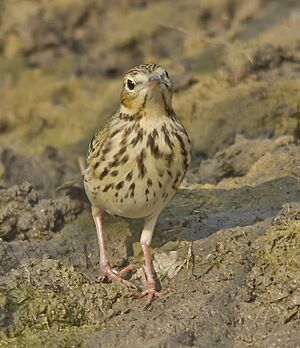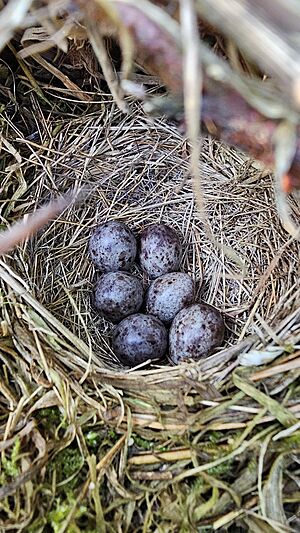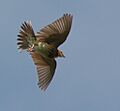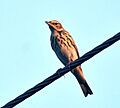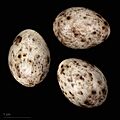Tree pipit facts for kids
Quick facts for kids Tree pipit |
|
|---|---|
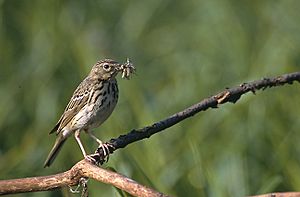 |
|
| Conservation status | |
| Scientific classification | |
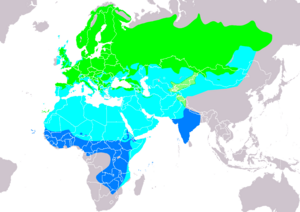 |
|
| Range of A. trivialis Breeding Non-breeding Passage | |
| Synonyms | |
|
The tree pipit (Anthus trivialis) is a small passerine bird known for its lovely song. It lives across most of Europe and Asia, reaching as far east as the East Siberian Mountains. These birds are long-distance travelers. They fly to Africa and southern Asia for the winter. The name Anthus comes from a Latin word for a small grassland bird. Trivialis means "common."
Tree pipits like to live in open woodlands and bushy areas. They build their nests on the ground. Usually, they lay 4 to 6 eggs. Like other birds in their family, they mostly eat insects. They also enjoy eating seeds.
Contents
Meet the Tree Pipit: What Does It Look Like?
This bird is a small pipit. It looks a bit like the meadow pipit. The tree pipit has brown streaks on its back. Its belly is white with black marks, and its chest is a buff (yellowish-brown) color.
You can tell it apart from the meadow pipit in a few ways. The tree pipit has a slightly bigger beak. Its buff chest and white belly also stand out more. Tree pipits also like to perch in trees more often than meadow pipits.
Their call is a strong spek sound. This is different from the softer call of their relatives. Their song flight is very special. The bird flies up a short distance from a tree. Then, it glides down with stiff wings. Its song gets longer and more drawn out as it floats down.
Where Do Tree Pipits Live?
Tree pipits breed in places that have some trees. This includes open woodlands and areas with low bushes. They often live where woodlands meet open moorland. They prefer open oak woodlands. This means the trees are spaced out, creating gaps.
They like medium-sized trees with low branches. They also prefer low-growing bushes and brambles that are less than 2 meters tall. This allows them to see around easily. They enjoy a mix of grass and ferns. They don't like very short grass that has been heavily grazed. So, light to medium grazing is best for their homes.
The Life Cycle of a Tree Pipit
Tree pipits follow a yearly journey:
- Mid-September to Mid-April: They spend their winter in areas south of the Sahara Desert in Africa.
- Mid-April to Early May: They migrate (fly) north. They arrive in countries like the United Kingdom.
- Early May to August: This is their breeding season. They usually have two sets of chicks.
- August to Mid-September: They fly back to Africa for the winter.
How Tree Pipits Behave
Nesting and Raising Chicks
Tree pipits build their nests on the ground. They hide them among clumps of grass or heather. The female bird builds the nest. She lays 4 to 6 eggs. The female then sits on the eggs to keep them warm. This is called incubation. The eggs hatch after about 12 to 14 days.
Both parents feed the young chicks. The chicks leave the nest when they are 12 to 14 days old. Sometimes, the nests of tree pipits are used by the common cuckoo (Cuculus canorus). The cuckoo lays its eggs in the pipit's nest, and the pipit parents raise the cuckoo chick.
What Do Tree Pipits Eat?
Tree pipits mainly eat invertebrates. These are small creatures without backbones, like insects. They also eat some plant material. They usually look for their food on the ground.
Images for kids
-
In Gujarat, India



